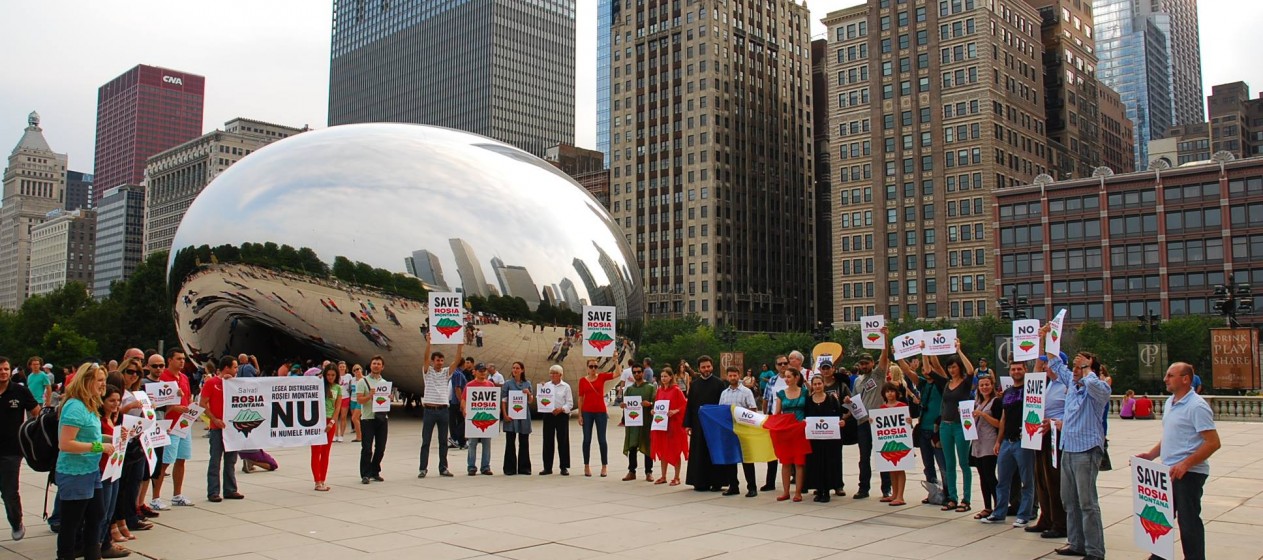For the past seven weeks, Romanians have been leading one of the largest environmental protest movements in the world. Around 200,000 Romanians have taken to the streets in cities across Romania and the world to protest against the government’s recent approval of draft legislation for an open-pit cyanide-based mining project at Rosia Montana. According to Gabriel Resources Ltd., the Canadian company behind the scheme, the plan for the project is to dig up an estimated 314 tonnes of gold squirrelled away in Rosia Montana, using 40 tonnes of cyanide per day.
Despite the protests, the European Commission (EC) did not make a statement until only recently. The Commission’s response was prompted when Commissioner Janez Potocnik received a letter soliciting information on the EC’s intended actions regarding Romania’s moves to accelerate the authorization of the mining project, which would use environmentally dangerous cyanide leaching technology.
But a spokesperson representing the Commission emphasized that it was not concerned with the Rosia Montana project because it so far does not breach any EU environmental regulations. The spokesperson added that, as long as the Canadian company obtains its needed licenses, the project would be fine.
The Commission is wrong. The project goes against two fundamental principles of the Lisbon Treaty: the sustainable development principle and the precautionary principle. Moreover, the project would breach several EU environmental Directives, such as Directive on the management of waste from extractive industry and the Water Framework Directive.
The European Commission should intervene for two reasons
For one, the Rosia Montana initiative breaches the Lisbon precautionary principle, which states that policy cannot harm the public or environment. According to the head of the Romanian Geological Institute, the soil at Rosia Montana could not support the post-mining decantation basin that the company intends to create, as cyanide would easily leak into groundwater. Moreover, the Institute mentioned that it would be unprecedented to have a decantation basin of 363 hectares of cyanide-filled waste, which means that the potential for a spill is all the more enormous.
Second, the project also runs afoul of the sustainable development principle. Gabriel Resources would obtain 80 percent of the profits, with the rest going to the Romanian government. This is too little for the East European country. Rosia Montana is the largest known gold deposit in Europe and the third largest in the world. Its value is estimated to be around at around $20.8 billion, representing a huge possible endowment for Romania – if managed properly. As the Romanian Academy, an academic forum, stressed, the mining project is ‘not a solution for sustainable development and does not solve the economic and social problems in the region’. While the company has promised to create 3,600 jobs, CNS Cartel ALFA, a trade union, puts the number at around 1,700 jobs. It reckons employment will fall to a paltry 300 after 8 years. Finally, the Canadian company intends to extract the gold over 16 years, approximately 35 years less that what an initiative of its size would usually take. According to the head of the Romanian Geological Institute, using the standard practice of carbon-in-leach (CIL) cyanidation and pressured oxidation of refractory gold minerals, a practice used in Finland’s Kittila Gold Mine, would mean extending the mining period by at least 33 years, adding more jobs and investment. But even this model would have severe problems.
Years of frustration
All of this comes after previous efforts to attract the attention of the European Parliament on the matter. In 2010 and 2011, Ad Astra, an association of Romanian scientists, and the Rosia Montana Cultural Foundation sent petitions in response to the project’s potential damaging effects on the environment. But the PETI Commission left it up to the Romanian authorities. Nevertheless, it highlighted that the project has to respect several directives, most of which the project breaches.
The first one is Directive 2006/21/EC on the management of waste from an extractive industry, which ironically was adopted after Romania’s 2000 Baia Mare cyanide spill, considered the worst environmental disaster in Europe since Chernobyl. Yet the Rosia Montana project has never been granted an environmental permit. According to a Romanian Europarliamentarian Monica Macovei, the company’s exploration license has been expired for 12 years, given that according to the Romanian mining law, in order to start any mining activity the company is obliged to obtain an environmental license within 180 days after the exploration license is granted.
The second European directive that would be breached by the project is the Water Framework Directive. The Rosia Montana project needs its tailings pond to be situated on the valley of the Corna River, whose course would have to be deviated. This is nearly impossible according to the director of the Geological Institute. But according to the European Water Framework, deviating the natural course of a river can only be done in the case of ‘projects of public utility’ and of ‘overriding public interest’. Alas, in recently approved draft legislation, the Romanian government declared the Canadian company’s private project to be of public utility and of overriding public interest, which it is not, given that the Romanian Constitution stresses that ‘public interest riches’, including underground resources, are the exclusive object of public property, meaning that they solely belong to the Romanian people.
What should be done?
To begin, the European Commission should revisit its statements regarding the Rosia Montana project. While the EU might be facing a dire economic crisis, allowing ecological disasters to occur in its Member countries is not beneficial and contradicts many of its core principles. The EU also seems to be ignoring the fact that, apart from being the largest gold mine in Europe, Rosia Montana contains extremely important rare minerals, including titanium, germanium and wolfram, whose tremendous global value far surpasses that of gold. At the same time, the precedent of having a unconstitutional law that allows a private foreign company the power to operate with little oversight in a European country is not a precedent to be desired. Finally, the EU should take into account the fact that significantly lowering the environmental standards in gold mining activities would set a grave precedent in Europe and enable not just the ecological disaster in Romania, but elsewhere in Europe.









19 Comments
Let us not forget the rest of the materials that are found at Rosia Montana, and which are, for the most of them, extremely rare ones (gallium, cobalt, germanium,and so on)! Tellurium is one of them, putting Rosia Montana on the second place in the world, after China, in deposit’s dimension – if we are to believe the sources. This clearly makes this exploitation a strategic one, and of vital importance for the E.U. and the rest of the world, from more then one point of view – durability and sustainability both included!
That way Romania would loose 314 – 6% = 295.16 tons of gold to have 1700 jobs over 16 years – which means THE COST FOR ROMANIA TO BE abt. 1 KILO OF GOLD PER CAPITA, PER MONTH [0.9043 kg = 295.16 tons of gold : (1,700 jobs x 16 years x 12 months).
No way there will be 1700 jobs… we’re talking about 800 and most of them are not for locals (only 200 people from R. Montana will actually work there, the others are specialists who are not from there)… so let’s be real: does it worth tu ruin the environnement forever????
The European Commission’ comments on the Rosia Montana issue makes me wonder if it’s a good idea that Romania joined EU.
Evidently EU is not protecting their member states against predatory practices, quite the opposite, they turn a cold shoulder to the whole situation.
The more I think about the whole setup, the more I tend to agree with Nigel Farage.
A short clip here for your viewing pleasure:
http://www.youtube.com/watch?v=2gm9q8uabTs
God Bless, and God save Rosia Montana
20.000 people around Rosia Montana would lose their jobs if cyanide will appear in Rosia Montana. Furniture companies were warned by french and italian contractors that they won’t buy their stuff if the project starts ( they claim wood would be poisoned ), no one would be able to sell milk / meat / vegetables / grains from that area ( who would buy ? ) and so on… basically the ‘Romania needs these jobs now’ slogan claimed by RMGC is a boomerang… check how wealthy the peruans are around Yanacocha
This article is wrong on many levels. The project has not polluted the environment at Rosia Montana, but will clean the historical pollution. As a result of the implementation of the Rosia Montana Project, not even one drop of contaminated water will leave the project site without prior treatment.
http://www.rosiamontananews.com/explainer/how-will-the-mine-impact-the-environment
This is a big **** my friend. Stop being such an ignorant! Water is most precious thing that we have on this earth, water have memory, water is all of us and around us! You cannot waste such an amount of water I’m not even talking about the wasted water contaminating rivers. Now wake up and be useful stop wasting your time writing this trash!
***Edited for language***
there is a lot of misinformation written here and elsewhere about the use of cyanide on this project. Cyanide occurs naturally in the environment and is used every day to make common products for our use. Its use is normal – 95% of gold mining operations worldwide use cyanide. Worth reading this website for some facts:
http://www.rosiamontananews.com/explainer/is-cyanide-really-dangerous
If 95% of gold mining operations worldwide use cyanide, that not mean it is good! I don’t want cancer and polluted environment, maybe you do but us, romanians we don’t want this shit in our country you can have it all my friend and all the money that comes from! We can survive like this in peace for a long time from now on. What about you?
You are talking about 13 times more cyanide used than in the whole Europe. If 95% of gold mining operations worldwide use cyanide, that not mean it is good! I don’t want cancer and polluted environment, maybe you do but us, romanians we don’t want this shit in our country you can have it all my friend and all the money that comes from! We can survive like this in peace for a long time from now on. What about you?
I also think the benefits to the local economy are under reported in blogs like this. According to the official website http://www.rosiamontananews.com the mine will create some 7,000 direct and indirect jobs during its construction phase and 3,600 direct and indirect jobs during its operational phase. Most of these jobs will be in the local area around Roşia Montană’s which is great news considering the current state of poverty.
It’s distasteful how shills (hopefully paid ones, because else it would be just plain sad somebody does something of that kind for free) like the three above (NewsflashRO, Oskar Tzara, Manuela Lupascu) don’t even have the decency to space out the timing of their comments from each other.
I guess even the paid shills are disgusted by the type of hype they’re supposed to be promoting and they are self-sabotaging the effectiveness? One can only hope that’s the case.
This type of misinformation (not to say outright lies) spread by them is typical of the kind of “desperate effort” this so called mining company is making for a while now, but it’s getting increasingly desperate and obvious lately.
The funny thing is the CNA (the rough Romanian equivalent of the American FCC) just forbade them from airing any more of their typical misleading commercials on the national TV stations (you really couldn’t get through more than one commercial break without a full-of-lies spot from them on just about any channel), so they’re redoubling their “spreading lies” campaign over the internet, with a declining quality of the comments and with even less efforts to conceal the fact it’s all just an act.
Right in the face my brother!
Yup, you can’t ask much from such country murdering stains m8. They can’t be very smart if they believe all that RMGC crap and spend their time hunting anti- exploitation articles around the web …
This is, in simple words, what the RMGC project is about:
– The project proposes 900 jobs during 16 years but will destroy another 20’000 jobs forever. Moreover, the Romanian Gvt has granted RMGC tax deductions, so the benefits to the romanians are very small, to the order of 10$ per person per year.
– The project says it wants to clean historical pollution (the company estimates the cleaning cost to $50millions) but it plans to pollute using cyanide quantities 13 times bigger than what is used in the rest of Europe put together, in much larger areas. 4 mountains will be exploded and the biggest cyanide lake in Europe will be constructed. No insurance company has accepted to cover the risks and the potential costs this project brings, which are enormous.
– The mining area is densely populated, there is a town at only 2km distance from the cyanide lake’s dam. The whole town and other villages will be left will no potable water because of pollution and huge quantities of fresh water needed to extract the gold and silver and form the cyanide lake.
– The cultural heart of romania will be destroyed; british scientists have estimated that the mining galleries are a unique site in the whole world and their enormous cultural value should be preserved in full.
– Apparently, the Romanian Government doesn’t care if it looses $16bn per year from tax evasion, and another $25bn during 6 years from not absorbing European funds… But it is determined to receive about $300millions per year from this abject mining project.
– Romanian government taxes mining revenues at only 0.5%, compared to 16% for other businesses, and dividends are not going to be paid in Romania so the state will not be able to tax them, meaning that the indirect benefits through taxes will be almost null.
– RMGC supporters created a company, Sociopol, in April 2013 to forge some studies that show that “70% of Romanians are in favour of the project”. If you have a look at Sociopol’s studies you’ll see that actually they haven’t done ANY OTHER study, except for the ones for RMGC; they do not offer any informations about the conditions used in their studies, they cannot even prove the study really did take place.
– The Geological Institute of Romania has proven that RMGC intentionally altered information related to the soil and deleted terrestrial fissures from the map presenting the geology of the cyanide lake. But those fissures exist, are real, and they will for sure let cyanide go to the groundwater.
– RMGC intentionally ignores the rare metals that are proven to exist in Rosia Montana. Even worse, from what they say, those metals will be either destroyed either unusable for another 125 years. These expensive rare earth elements are vital for technological development and their importance is acknowledged by the European Commission.
The Rosia Montana mining project is not economically and environmentally sustainable. The mining company has invested millions of euro for political lobby and aggressive publicity in favour of the mining project. The whole project is based on fraud and corruption. People in Romania need SUSTAINABLE development. This mining project is clearly not sustainable when in 16 years will leave behind only massive destruction. After the exploitation is over that whole area will be completely contaminated with dangerous substances and thus it will be completely useless. There is going to be NOTHING left. People around it will have even more problems compared to now.
Things to know about Rosia Montana mining project:
– The project proposes 900 jobs during 16 years but will destroy another 20’000 jobs forever. Moreover, the Romanian Gvt has granted RMGC tax deductions (the income tax in miming is only 0.5% and there will be no dividends to be taxed because they are paid in tax heavens), so the benefits to the romanians are very small, to the order of 10$ per person per year.
– The project says it wants to clean historical pollution (the company estimates the cleaning cost to $50 millions) but it plans to pollute 100 times more, in much larger areas. 4 mountains will be exploded and the biggest cyanide lake in Europe will be constructed. No insurance company has accepted to cover the risks and the costs this project brings, which are enormous.
– The mining area is densely populated, there is a town at only 2km distance from the cyanide lake’s dam. The whole town and other villages will be left will no potable water because of pollution and because of the huge quantities of fresh water needed to extract the gold and silver.
– The cultural heart of romania will be destroyed; british scientists have estimated that the mining galleries are a unique site in the whole world and their enormous cultural value should be preserved in full.
– Apparently, the Romanian Gvt. doesn’t care if it looses $16bn per year from tax evasion, and another $25bn during 6 years from not absorbing European funds… But it is determined to receive about $300 millions per year from this abject mining project.